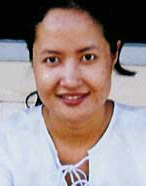 |
||
|---|---|---|
| CP Foundation | About CP Biennale | 2003 | 2005 | Contact Us | >||
           
|
||
|
In her musings, Bunga actually questions more about the reasons why the artists' insanity is often taken for granted. The most intricate cause is apparently the difficulty in communicating thoughts, especially through artistic symbols. Her installation project, Things Will Happen When They are Ready (2003), reveals her effort to raise this perplexing issue. The installation projects depict the communicative chain among symbolic objects. There is a painting of three little girls in a garden, busily playing around. The installation reveals an intriguing reality as a sculpture of a little child is put in front of the painting, with a gesture and expression as if the child is explaining the painting to twelve confused cats. It is clear here that Bunga dares to "force" the communication flow from the painting of the self-absorbed little girls to the sculpture of the child, and from the child to the cats. Such depiction might have been inspired by her own experience with the many cats she keeps as pets. This installation work, however, is not merely a representation of some expressive scenes. Here, Bunga turns her objects into some naïve-looking dolls, which might remind us to some decorative objects in our daily lives. The important thing in this work is how Bunga shocks us with her presentation about the issue. She steals our attentions, makes us think about the incomprehensible values in every communication process. It is also apparent in the particular style of her work that Bunga is one of the artists who are celebrating the emergence of new idioms in Indonesian contemporary art. The works of Bunga, often questioned the daily problems linked with the female lifestyle and norms. Bunga, who had studied painting in ISI Yogyakarta, is also known for her emphatic works about animals. Using image of animals, She then went on to explore the territory of sculptures and started to compose objects in installation works. M. Agus Burhan Born on May 8, 1972 in Solo, Central Java. SELECTED SOLO EXHIBITIONS SELECTED GROUP EXHIBITIONS |
||
|
CP Foundation | About CP Biennale | 2003 | 2005 | Contact Us
Jl. Suryopranoto 67A, Jakarta 10160, Indonesia. ph. +62.21.3448126, 3853206 | fax. +62.21.3853203, 3853208 info@cp-foundation.org |
||
 The public often takes for granted an artist's insanity as a normal symptom of a highly creative individual. This is apparently justified by the abundance of incomprehensible works created by such an artist. The absence of communications and the endless innovations create the image of the artist as a fool wandering in the dark alleys of the general norms. The truth and essence of the "foolish artist", however, can only be proven by the strength of his or her works. As an artist herself, Bunga Jeruk has the sensibility to question the phenomenon often thought as a norm by the public. She warily asks whether the insanity is an intrinsic part of an artist, dictated by the genes, and that whether it becomes the source of the creative energy. Or is it possible that the artist's insanity is only situational and can therefore be artificial?
The public often takes for granted an artist's insanity as a normal symptom of a highly creative individual. This is apparently justified by the abundance of incomprehensible works created by such an artist. The absence of communications and the endless innovations create the image of the artist as a fool wandering in the dark alleys of the general norms. The truth and essence of the "foolish artist", however, can only be proven by the strength of his or her works. As an artist herself, Bunga Jeruk has the sensibility to question the phenomenon often thought as a norm by the public. She warily asks whether the insanity is an intrinsic part of an artist, dictated by the genes, and that whether it becomes the source of the creative energy. Or is it possible that the artist's insanity is only situational and can therefore be artificial?